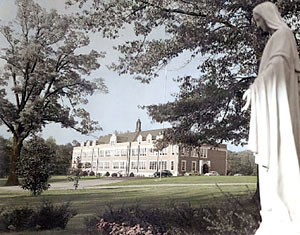
Christian Brothers University
In 1864 the Brothers of the Christian Schools applied to begin a school “of higher education” in Memphis, but yellow fever epidemics in Galveston and New Orleans killed several Brothers, and they canceled the project. Another attempt in 1871 succeeded, though, and from this date until the present, the Brothers have continuously contributed to Memphis education.
The Memphis clergy was determined to establish Catholic education in Memphis. The clergy envisioned not only elementary and secondary education, but college education, too. Ironically, a number of unforeseen difficulties arose that resulted in the Brothers making a place for themselves in Memphis.
The closing of the Memphis Female College made that property available, but the Chicago fire of 1871 assured the beginning of Christian Brothers College in Memphis when it destroyed the Brothers’ Academy in Chicago and left a number of Brothers available for other duties. Several came to Memphis and Brother Maurelian came from Pass Christian, Mississippi, to be the school’s first president. Dedication of the college on Adams Avenue occurred on Sunday, November 19, 1871.
The nineteenth century was mainly a period of struggle for Christian Brothers College. Recovery from the Civil War and Reconstruction was tedious, and yellow fever and financial difficulties particularly plagued the city and the Brothers’ community. Three epidemics in the 1870s took their toll on Memphis and the college. Also in debt, the college barely survived the financial Panic of 1873. The final problem of this century arose over the prohibition of the teaching of Latin in the colleges of the Christian Brothers in the United States. The Memphis Brothers objected, but they adjusted and began the instruction of modern languages.
Despite the school’s growth in the early twentieth century, the Memphis college would be sacrificed to another Brothers’ college in St. Louis. Not surprisingly, the Saint Louis District of the Christian Brothers had concluded that there were not adequate resources to support two colleges within the district. Therefore, in June 1915 the college awarded its last college degrees for several decades; Christian Brothers College became a high school.
From the end of World War I through the 1920s and the depression, the school grew. Its enrollment outgrew the Adams Avenue facility, and in 1940 the school moved to the suburbs on East Parkway. In addition to inaugurating a new phase of its history on East Parkway, the school opened a junior college department. World War II, however, forced the closure of the junior college.
The last thirty-five years have been among the most active in the college’s history. Physical and academic expansion continued; in 1965 the college and high school separated, with the high school moving further east, and in 1971 the college admitted women. In the 1990s Christian Brothers became a university, reinstituted a teacher’s education program, and began three master’s programs. During 1996-97, university athletics entered Division II of the NCAA. From its beginning on Adams Avenue with four brothers and eighty-seven students, Christian Brothers has grown to a university offering both bachelor’s and master’s degrees, with a faculty of over one hundred and a student body of more than eighteen hundred enrolled in day and evening programs. On November 17, 1996, the University celebrated its 125th anniversary.
Suggested Reading
W. J. Battersby, F.S.C., The Christian Brothers in Memphis: A Chronicle of One Hundred Years, 1871-1971 (1971)



